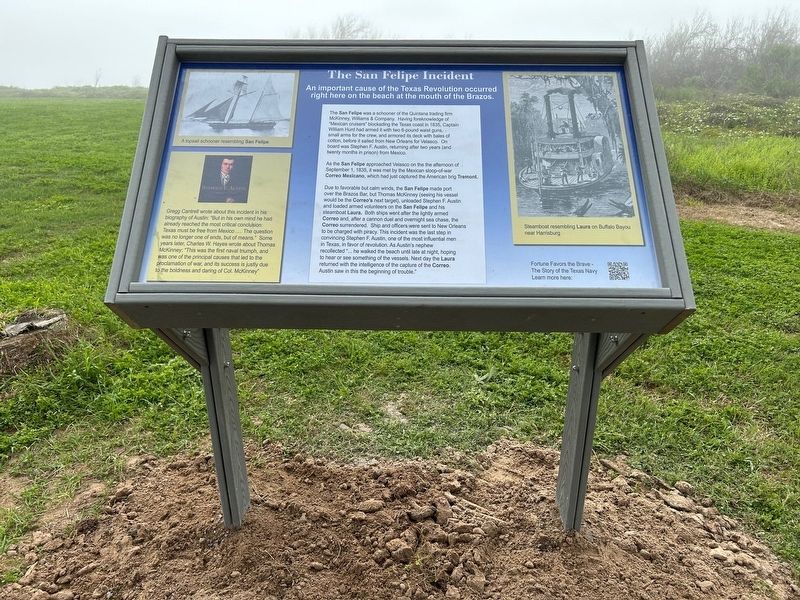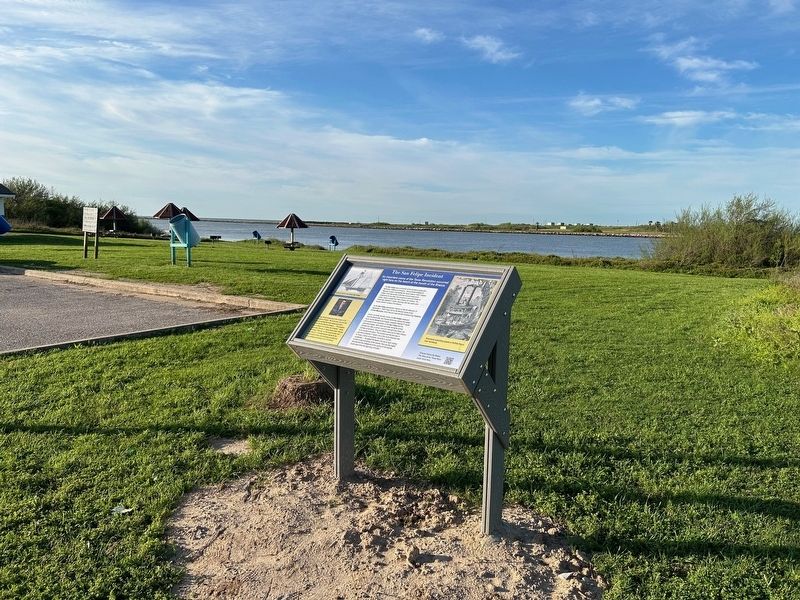Surfside Beach in Brazoria County, Texas — The American South (West South Central)
The San Felipe Incident
An important cause of the Texas Revolution occurred right here on the beach at the mouth of the Brazos River.
The San Felipe was a schooner of the Quintana trading firm McKinney, Williams & Company. Having foreknowledge of "Mexican cruisers" blockading the Texas coast in 1835, Captain William Hurd had armed it with two 6-pound waist guns, small arms for the crew, and armored its deck with bales of cotton, before it sailed from New Orleans for Velasco. On board was Stephen F. Austin, returning after two years (and twenty months in prison) from Mexico.
As the San Felipe approached Velasco on the afternoon of September 1, 1835, it was met by the Mexican sloop-of-war Correo Mexicano, which had just captured the American brig Tremont.
Due to favorable but calm winds, the San Felipe made port over the Brazos Bar, but Thomas McKinney (seeing his vessel would be the Correo's next target), unloaded Stephen F. Austin and loaded armed volunteers on the San Felipe and his steamboat Laura. Both ships went after the lightly armed Correo and, after a cannon duel and overnight sea chase, the Correo surrendered. Ship and officers were sent to New Orleans to be charged with piracy. This incident was the last step in convincing Stephen F. Austin, one of the most influential men in Texas, in favor of revolution. As Austin's nephew recollected "... he walked the beach until late at night, hoping to hear or see something of the vessels. Next day the Laura returned with the intelligence of the capture of the Correo. Austin saw in this the beginning of trouble."
Greg Cantrell wrote about this incident in his biography of Austin: "But in his own mind he had already reached the critical conclusion: Texas must be free from Mexico .... The question was no longer one of ends, but of means." Some years later, Charles W. Hayes wrote about Thomas McKinney: "This was the first naval triumph, and was one of the principal causes that led to the proclamation of war, and its success is justly due to the boldness and daring of Col. McKinney"
Erected 2024 by Old Fort Velasco Historical Association and Old Velasco; Surfside Beach Historical Committee.
Topics. This historical marker is listed in this topic list: War, Texas Independence. A significant historical year for this entry is 1835.
Location. 28° 56.444′ N, 95° 17.932′ W. Marker is in Surfside Beach, Texas, in Brazoria County. Marker can be reached from the intersection of Parkview Road and Monument Ave.. Touch for map. Marker is at or near this postal address: 600 Parkview Road, Freeport TX 77541, United States of America. Touch for directions.
Other nearby markers. At least 8 other markers are within walking distance of this marker. Republic of Texas Battery (within shouting distance of this marker); Confederate Civil War Forts at Mouth of Brazos (about 300 feet away, measured in a direct line); First Republic of Texas Navy: 1835-1837 (about 500 feet away); Battle of Velasco Memorial (about 600 feet away); Brown-Hoskins Hotel and Tavern (about 700 feet away); The Lively (about 700 feet away); Santa Anna signed Treaties of Velasco (about 800 feet away); Allen Place, 1883 (approx. 0.6 miles away). Touch for a list and map of all markers in Surfside Beach.
More about this marker. This marker is one of a set of six historical trail signs installed along a jetty-side hiking trail in Feb-Mar 2024 at the site of Old Velasco at the old mouth of the Brazos River, as near as possible to the actual location featured in the sign.
Regarding The San Felipe Incident. This location is the approximate area where the beach existed in the 1830's. It is significant since the "Father of Texas" Stephen F. Austin watched with his own eyes from that beach, and afterwards he spoke for revolution, probably causing further incidents such as the Battle of Gonzales one month later -- on a path to the Texas Revolution. Thus, it was the true "opening shot of the Texas Revolution". No less an authority than the Texas State Library and Archives agrees (as do most Texas history books written before 1900), as shown in their web page:
https://www.tsl.texas.gov/exhibits/navy/felipe.html
Thus, together with the Treaties of Velasco, it can be said that the Texas Revolution started and ended within yards of each other at Old Velasco! Come and stand on these very spots!
Also see . . .
1. The San Felipe Incident: Opening Shot of the Texas Revolution. (Submitted on March 26, 2024, by Chris Kneupper of Brazoria, Texas.)
2. The San Felipe Incident. (Submitted on March 26, 2024, by Chris Kneupper of Brazoria, Texas.)
Credits. This page was last revised on March 28, 2024. It was originally submitted on March 26, 2024, by Chris Kneupper of Brazoria, Texas. This page has been viewed 58 times since then. Last updated on March 27, 2024, by Chris Kneupper of Brazoria, Texas. Photos: 1, 2. submitted on March 26, 2024, by Chris Kneupper of Brazoria, Texas. • Devry Becker Jones was the editor who published this page.

